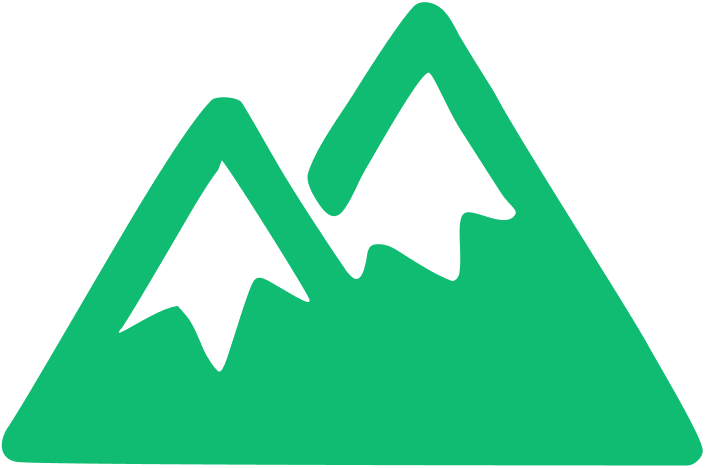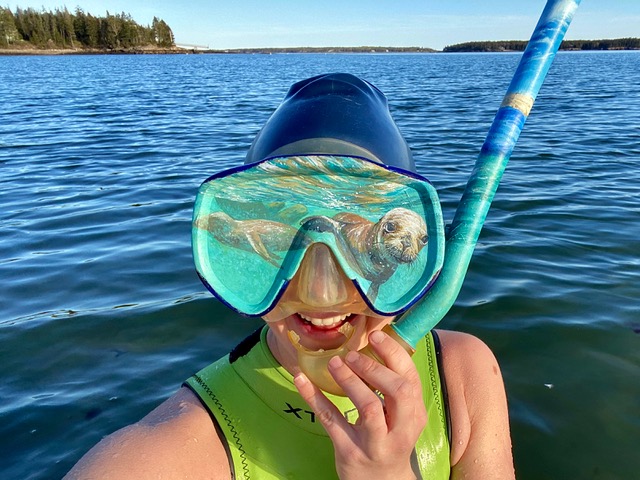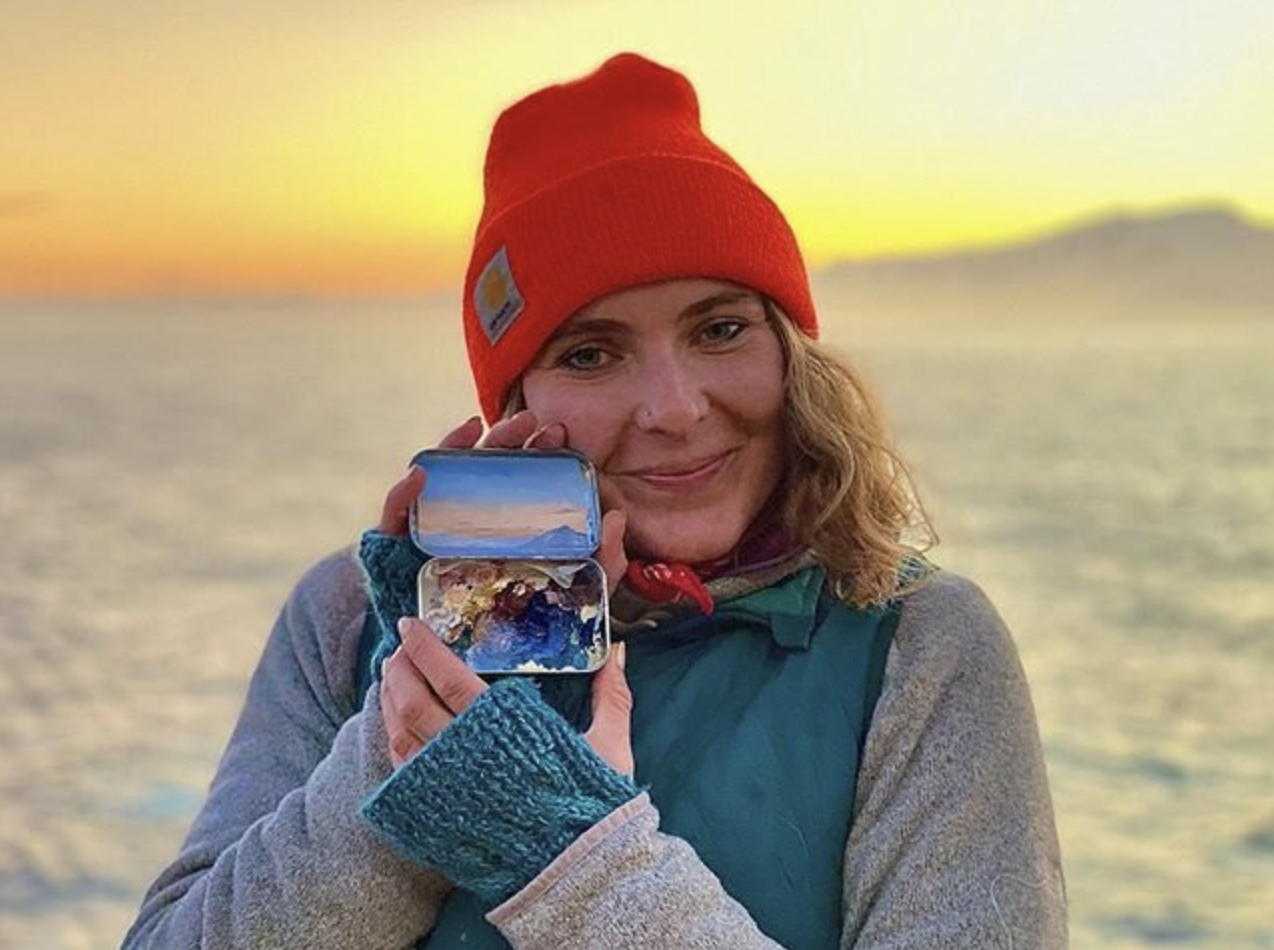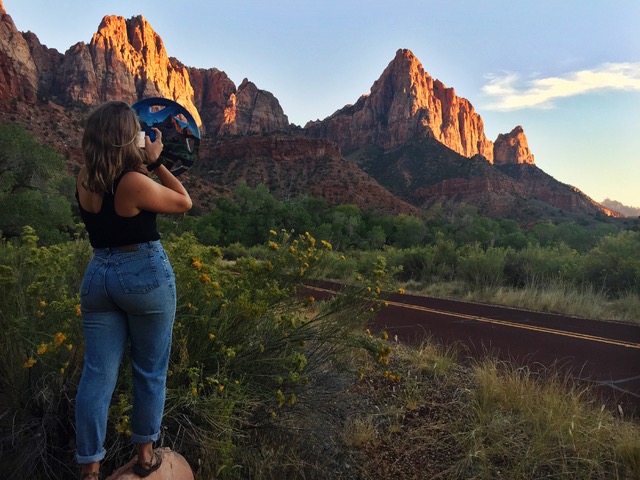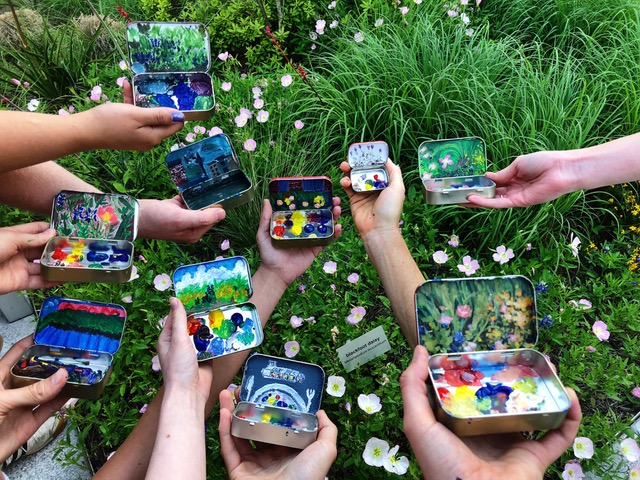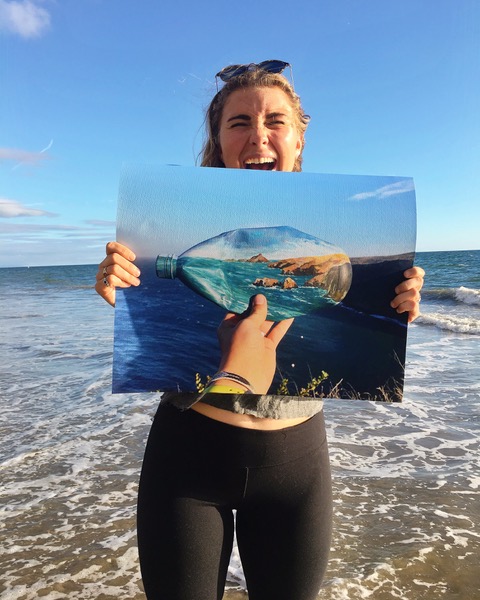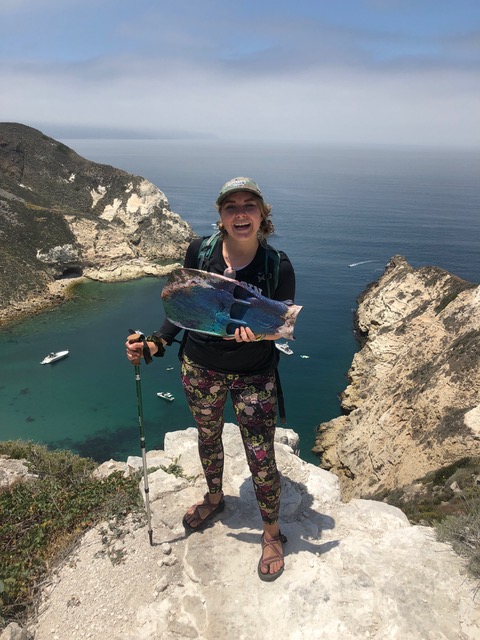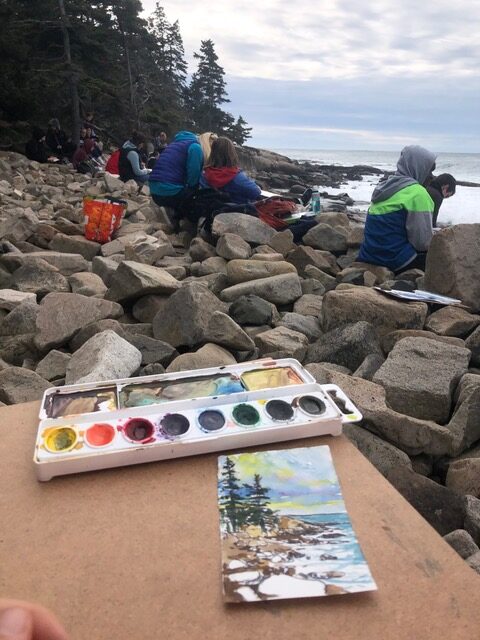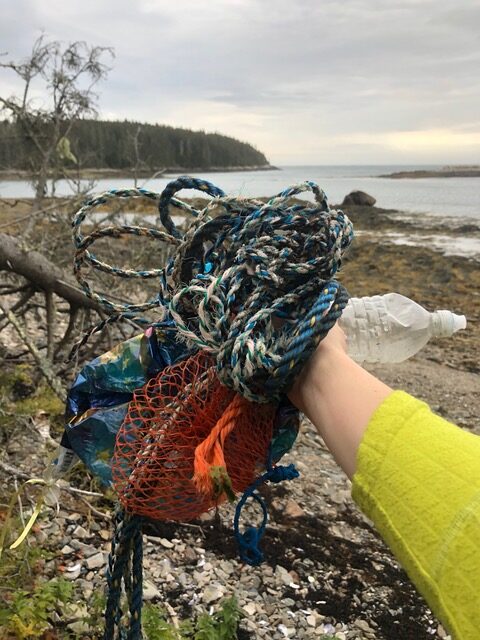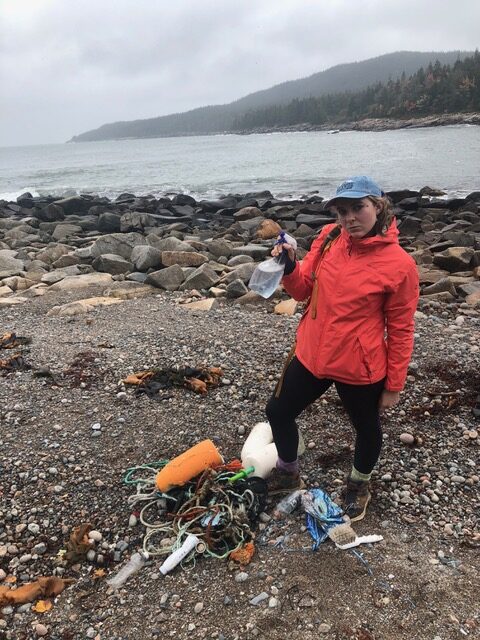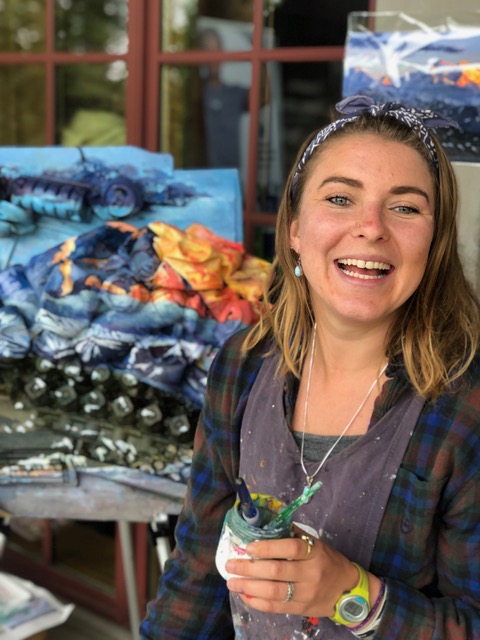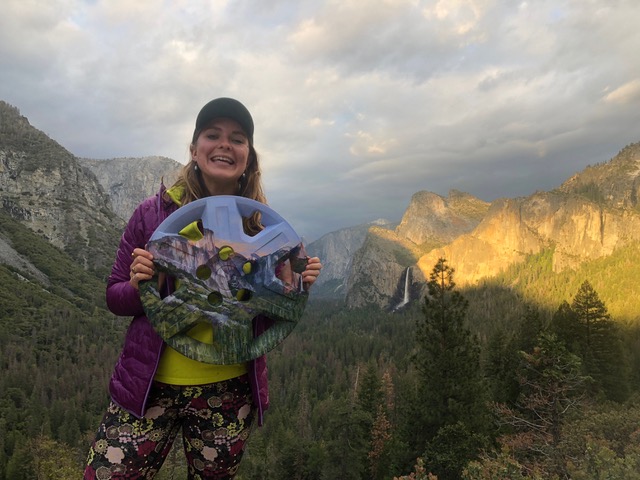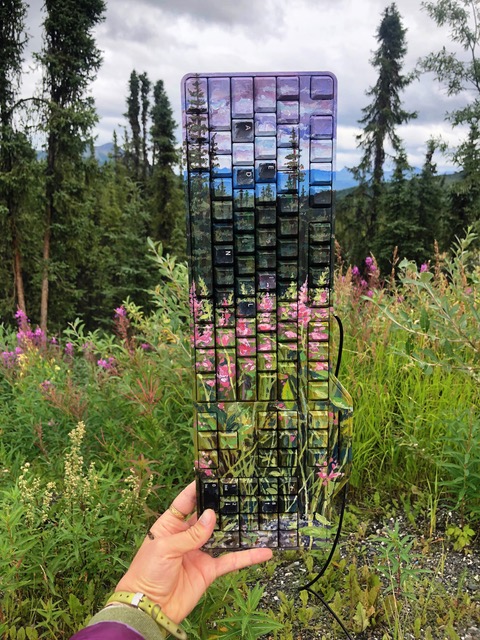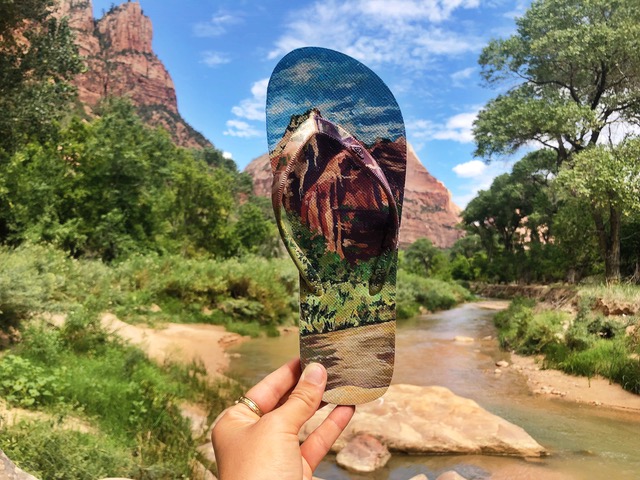Meet the Eco-Artist Recycling National Park Trash Into Impressionist Landscape Art
Eco-artist and landscape painter Mariah Reading advocates for the existence, preservation, and sustainability of National Parks through unique paintings on canvases made from trash found in the parks. Mariah then photographs the painted object within its original found environment, to “both obscure and highlight the discarded object.” Inspired by her art, advocacy, and commitment to the environment, US Park Pass spoke with Mariah as part of our Meet the Artisans of the National Parks series.
USPP: How did you get started as an eco-artist?
I grew up in Maine surrounded by forests, rivers, lakes, and ocean, while being supported by parents who fostered a love for art. I went on to study visual art and education in college and began to register just how much waste artists produce, and how much debris I personally threw out after each project. As a landscape painter, I couldn’t justify contributing more waste to landfills and further harming the landscapes that have inspired me throughout my life. To confront my own consumption, I started sculpting personal trash into canvases onto which to paint landscapes.
My “Recycled Landscapes” project actually sparked from a dream where I saw myself picking up trash in the National Parks. That same summer, which happened to coincide with the National Park Centennial (in 2016), I planned a cross-country road trip with my dad to travel to a teaching position in California. I normally don’t remember my dreams so, feeling particularly inspired, I began collecting trash in Acadia National Park (Wabanaki Confederacy Land) and kept at it as I worked my way to the West Coast, stuffing my already stuffed car with literal trash in order to turn it into art. Over the past few years, this seed of an idea has transformed and expanded into sculptures, paintings, prints, and installations.
So many things! I’ve been privileged to live in locations where the scenery is vast and wild but also intimate and delicate. For a long time, I thought I was most inspired by the ocean. I grew up only an hour from the Atlantic Coast, went to college even closer, and then moved to the Pacific Coast. It wasn’t until 2017, when I volunteered for the Guadalupe Mountains National Park in West Texas (Jumanos / Mescalero Apache Land)—hundreds of miles from the nearest ocean—that I realized how inspiring a big sky is. There would be nights where I would sit outside, gazing over the horizon, and see a booming thunderstorm over the salt flats as a neon orange sunset blanketed the world’s largest exposed fossil reef. It’s hard not to feel a sense of awe watching the sky dance like that.
USPP: What values does your art embody?
Accessibility within the arts is something I strive for in my work. You don’t have to purchase expensive art materials and gear in order to create! Canvases can be found inside the recycling bin of your own home or from debris found outside your front door.
In a world experiencing climate change, limiting my waste is essential. I have done this by repurposing cardboard for shipping, recycling water, and eliminating plastics. I continue to learn, grow, and mitigate: I recognize my own human imperfections and use my work to confront my personal consumption habits and work towards phasing them out completely. I want my work, my habits, my mistakes, and my growth to be transparent.
Because my work is about climate change and pollution, it’s inherently linked with racial justice. Climate change has disproportionately affected BIPOC communities. Toxic landfills are far more likely to be concentrated in BIPOC communities, further exposing them to low air and water quality. Recognizing this inequity within my art and using my privilege to amplify this intersection is a necessity.
USPP: What part of your craft do you love the most?
I have been amazed at how limiting my medium to debris has opened up so many realms and tangential projects. One of my favorite things is when people who know of my art give me pieces of trash! It seems silly to be like, “Hey I found this garbage and thought of you!” but that type of collaborative process makes me so happy. Limiting waste, cleaning up the environment, and taking responsibility for climate change is not a one-person job. In order for anything positive to happen, it must be a collaborative effort. Those small acts give me hope that the effort is in full swing!
There’s also no beating the moment where I align a finished painting with its original environment and everything fits exactly into place for the photograph. This is especially satisfying if I’ve had to work remotely on a piece, painting using reference photos, and have had to hike it back out to its original location on a completely different day—and sometimes season! There is a large element of improv in my work and that keeps the process fresh and in motion.
USPP: How do you spend time at the National Parks?
I try to spend as much meaningful time as I can in every park I visit. Sometimes, the time is cut short or rushed but, as much as possible, I strive to pause within these lands because a surface-level visit doesn’t unveil all of the unique beauties that more time can reveal. Painting has been a tool for me to sit still and focus on the landscape in front of me, notice the small moments of moss by my feet, or the slight shifts in lighting as the sun dips towards the horizon. I also enjoy backpacking, kayaking, and swimming as ways to get immersed within these inspiring lands.
USPP: How have Yellowstone or other National Parks around you played a role in your craft?
Yellowstone (Crow and Cheyenne Land) was actually the first National Park I worked in! I led backpacking/kayak pack trips for teens in Yellowstone and the Grand Tetons (Shoshone-Bannock, Eastern Shoshone, and Cheyenne Land) the summer before my senior year of college. I had never seen that part of the country and was blown away by its unyielding gorgeousness and power. While kayak-packing on Yellowstone Lake, we were swept vigorously with white caps, camped in bear country, and had our water bottles freeze solid. That summer left me feeling completely empowered and invigorated as a woman in the outdoors.
Acadia has been another impactful park for my work. Growing up in Bangor, Acadia was only an hour away. Although it’s one of the smaller parks, it has 3.5 million annual visitors and is the seventh-most visited park in the system. Feeling the overwhelming tension between extreme beauty and over-visitation and accompanying pollution first inspired this project back in 2016.
USPP: What is unique about your practice?
My art prioritizes limited waste as I continue to work towards a zero-waste studio. The physical pieces of trash are painted only on one side and intentionally left untouched on the reverse so the original piece of debris remains evident. I sell and display both the 2D printed imagery of my landscape paintings and the physical sculpted paintings together, so viewers can not only visualize the environment where the trash was found but also contemplate the trash as its own object.
USPP: What advice would you give to other artists or small businesses starting out?
Take things one step at a time. I had been reluctant to start a business because it just seemed so overwhelming. Being an artist, my brain doesn’t naturally default to the business side of things but, with practice, I have slowly learned the tricks of the trade. I was able to find free resources within my community that laid-out the process in a very approachable manner. I spent this past winter chipping away at tasks that led me to where I am now. It’s an ongoing process that’s never finished but, once the front-loading is complete, it becomes more manageable and even enjoyable! Logging everything; talking with friends and other business owners; and just taking a leap have been the three most helpful steps I have taken.
USPP: What are some struggles that you have faced as a small business owner?
I struggle to find balance. I am a seasonal naturalist and focus on my art in the winter. The management (even though I am only managing myself) has been a learning curve. I love social media but keeping up with that, updates to the website, making money, and paying rent, while also applying to shows and moving every six months is taxing. However, the struggles have made my art into what it is today and I am continually learning to deal with them in healthy ways!
USPP: Are you the only one involved in creating your art or do you work with others?
I am the sole proprietor of my business but that isn’t to say that I work completely alone! I am constantly learning from others around me and seeking ways to collaborate across disciplines. My family and friends have also been huge supporters throughout this process. One of my largest pieces to date is a bulky, busted aquaculture box I found on a cobblestone beach in Acadia while my parents were visiting. There is no way I could have removed it from the rocky coastline by myself! Friends with whom I was working on a video project in January also helped me bring the box back to the park to align and photograph it in its original place of discovery.
USPP: What is something no one has ever asked you about your craft that you want your audience to know about?
I have been thinking a lot about the reasoning behind my hand being in the frame of my photographs. My focus is to paint landscapes, however, I also want to acknowledge that every single park I paint has an Indigenous presence in it. There is an upsetting history of white Western landscape painters leaving out the Indigenous people in order to view the land as “untouched and wild.” This act is an erasure of the humans that have been living on this continent for over 15,000 years. The inclusion of a hand within my frame is meant to acknowledge the human interaction and presence within these lands while also recognizing that my white skin has given me access to many park spaces from which others have been pushed out.
USPP: Anything else you want to add about you and your business?
I sell both original paintings and corresponding fine art prints and do commissions throughout the year. My tendency has been towards creating limited editions of specific prints, to reduce the energy and waste, and also make each print that much more special. My life is transient and my art and business follow that pattern as I wind throughout the dynamic beauty of this land.
